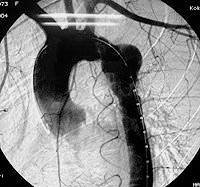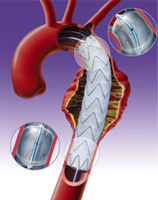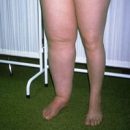Aortic aneurysm in most cases occurs during atherosclerosis, but the cause of the disease may be a marfana syndrome, syphilis or tuberculosis. The main risk factors are obesity, heredity, high blood pressure and smoking.
Content
The concept of the aneurysm of the thoracic aorta
 Aorta is the largest arterier in our body. Through her blood goes from the heart to all organs and tissues. Going out of the heart, the aorta passes through the chest, where it is called the Breast Department. Through this aorta department, the blood comes to the tissues and organs of the chest. Next, the aorta passes through a diaphragm where it is called the abdominal department. At the very bottom of the abdominal, the aorta is divided into two branches - iliac arterys responsible for blood supply to the lower abdomen, legs and genital organs.
Aorta is the largest arterier in our body. Through her blood goes from the heart to all organs and tissues. Going out of the heart, the aorta passes through the chest, where it is called the Breast Department. Through this aorta department, the blood comes to the tissues and organs of the chest. Next, the aorta passes through a diaphragm where it is called the abdominal department. At the very bottom of the abdominal, the aorta is divided into two branches - iliac arterys responsible for blood supply to the lower abdomen, legs and genital organs.
Special shattered expansion of the wall of the abdominal aorta, which arises due to thinning its wall, is called the aneurysm of the thoracic aorta. Approximately 25% of the aortic aneurysm is located in the thoracic department. The fact is that with a rather powerful blood pressure on a weakened aorta wall, it occurs its balluloneal expansion of a certain area of its. Normally, the diameter of the aorta is 2 cm. However, with the aneurysm of the aorta, its diameter may be stretched to dangerous sizes. The danger of the aneurysm of any degree of aorta is that its bundle may occur or even the gap, which leads to massive internal bleeding and death.
Special view of the aortic aortic aneurysms is the so-called aortic aneurysm. This type of aneurysm is usually associated with high blood pressure. The latalization of the aorta can spread through the entire aorta, thereby blocking blood flow to the legs, hand, kidney, head and spinal cord and other regions.
The danger of the aneurysm of any degree of aorta is that its bundle may occur or even the gap, which leads to massive internal bleeding and death.
In addition, aneurysm can contribute to the formation of blood clots. These blood clots carry blood flow to the organs, and can cause the blockage of the vessels, which leads to the strongest pains, as well as the impaired blood flow in the limb and its necrosis.
Sometimes aneurysm can occur in both aortic departments. Only 20-30% of hospitalized patients with an aneurysm of the thoracic aorta survive. This once again indicates the importance of as early as possible the aortic aneurysm as possible.
Basic symptoms of the disease
Only half of the sick aneurysm of the thoracic aorta are noted any symptoms. Sometimes the patient can feel nothing at all. The severity of symptoms depends on the location of the aneurysm, its size, the presence of a bundle:
- Pain in the lower jaw, neck and top of the back
- Pain in chest or back
- cough, fucking voice, breathing difficulty
With significant dimensions of aneurysm, it may compress heart valves, which leads to the development of stagnant heart failure. The symptoms of the aneurysm of the nessenger of the nuclear aorta may arise suddenly. For example, the patient can feel the strongest burning pain in the chest or back. Rarely, the patient may not notice any signs at all.
It is very important at the first signs of the emergence of the aneurysm of the thoracic aorta immediately to consult a doctor.
Causes of disease development
Researchers consider the main reason for the development of this pathology atherosclerosis. Normally, the inner wall of arteries and aortes smooth and smooth. In atherosclerosis on its surface, growths appear - atherosclerotic plaques. They consist of cholesterol, calcium and fibrous fabric. Over time, this process leads to a narrowing of the lumen of arteries and aortes, and ultimately to the loss of their elasticity and weakness of the wall. Other risk factors for the aortic aneurysm:
- obesity
- Availability of a direct relative (mother, brother), ill-meant aortic aneurysm
- high blood pressure
- smoking
In some diseases, the risk of damage to the inner wall of the aorta is also noted, which leads to the development of the aneurysm:
- Marfan syndrome (special connection of connective tissue)
- syphilis
- tuberculosis
Less likely the cause of the aneurysm of the thoracic aorta may be injury, such as drop or quick braking.
The risk of aortic aortic aortic increases. Aortic aneurysm more often sick men. The larger the size of the aneurysm, the faster it grows and the higher the probability of its break. Risk of rupture increases when the aneurysm size is twice the normal diameter of the aorta.
Methods of diagnosis of the disease
Most often aortic aneurysm is found during any procedure for studying the patient, for example, with ultrasound examination. If the doctor suspects you have aortic aneurysm, it can recommend:
- Radiography of the chest
- Ultrasonic Heart Study (Echography)
- Magnetic resonance imaging
- CT scan
- angiography
Options for treating the aneurysm of the thoracic aorta
Expectant tactic
If the dimensions of the aortic aortic aortic either does not cause anxiety, the doctor may recommend that so-called expectant tactics, which means that every 6 months you will be examined to identify any changes in the aneurysm sizes. To do this, it is necessary to regularly carry out an ultrasound study, or computed tomography or magnetic resonance tomography. Tomography is the method of X-ray layer-by-layer study of organs and tissues. It allows the doctor to control the aortic aneurysm diameter. This method is used for aneurysm with a diameter of less than 5 cm. If, in addition, you suffer high blood pressure, then the doctor can prescribe to you drugs that reduce it, which helps to reduce blood pressure on a weakened aorta wall. If you smoke, you need to quit smoking. Aneurysm itself is not going anywhere. Therefore, it is very important to constantly consult with your doctor, since with time aneurysm can achieve dangerous sizes, which is fraught with complications.
Treatment of the aneurysms of the thoracic aorta depends on the localization of it, sizes, as well as the disease that caused the aneurysm. For example, patients with marfana syndrome needed earlier treatment, in contrast to patients with the same aneurysm, but without marfana syndrome. To date, there are two types of treatment aneurysm: open method and endovascular.
Open surgical intervention
 The method of open surgical intervention lies in the fact that the surgeon reveals the chest, highlights the aorta area affected by aneurysm and replaces it with a synthetic prosthetic in the form of a tube. Often, the aneurysm of the thoracic aorta is combined with heart disease. With such complex types of lesions of the aorta, as well as the heart valves, operation is performed on the heart, depending on the situation.
The method of open surgical intervention lies in the fact that the surgeon reveals the chest, highlights the aorta area affected by aneurysm and replaces it with a synthetic prosthetic in the form of a tube. Often, the aneurysm of the thoracic aorta is combined with heart disease. With such complex types of lesions of the aorta, as well as the heart valves, operation is performed on the heart, depending on the situation.
After the operation, the patient is in the hospital within 6-7 days. In the case of a complex aneurysm or in the presence of concomitant diseases of the heart, lungs or kidney, the patient may be required from 2 to 3 months for rehabilitation.
Endovascular intervention
More modern method of treatment aortic aneurysms (and not only aortes) in this form of endovascular surgery as stenting. Term «Endovaascular» means that the operation is carried out inside the vessel with a special catheter, which is introduced into the clearance of the vessel. This type of operation is minimally invasive. This means that for the operation, the surgeon needs to produce only a small incision in the region of the grooves, through which the catheter is introduced. During the operation, the X-ray image is taken in real time, which allows the surgeon to control the process of conducting a catheter in the vessel. Next, the surgeon enters into the lumen of the aorta special fixture -. This is a cylindrical shape of a wire frame that strengthens the wall of the aorta. Rehabilitation period after this type of operation is only 2 -3 days. However, after the operation, it requires a rather frequent radiological control over the state and functioning of the installed stent. In addition, it may happen that this method does not suit you, for example, if you have a kidney pathology. It should be noted that in some cases the open operation is more acceptable.









